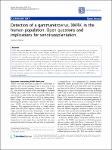Detection of a gammaretrovirus, XMRV, in the human population: Open questions and implications for xenotransplantation
Denner, Joachim
XMRV (xenotropic murine leukaemia virus-related virus) is a gammaretrovirus that has been detected in human patients with prostate carcinoma, chronic fatigue syndrome (CFS) and also in a small percentage of clinically healthy individuals. It is not yet clear whether the distribution of this virus is primarily limited to the USA or whether it is causally associated with human disease. If future investigations confirm a broad distribution of XMRV and its association with disease, this would have an impact on xenotransplantation of porcine tissues and organs. Xenotransplantation is currently being developed to compensate for the increasing shortage of human material for the treatment of tissue and organ failure but could result in the transmission of porcine pathogens. Maintenance of pathogen-free donor animals will dramatically reduce this risk, but some of the porcine endogenous retroviruses (PERVs) found in the genome of all pigs, can produce infectious virus and infect cultured human cells. PERVs are closely related to XMRV so it is critical to develop tests that discriminate between them. Since recombination can occur between viruses, and recombinants can exhibit synergism, recipients should be tested for XMRV before xenotransplantation.
No license information

